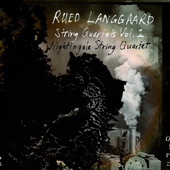

String Quartet No. 2, BVN 145
String Quartet No. 3, BVN 183
String Quartet No. 6, BVN 160
Variations on "Mig Hjertelig Nu LŠnges" (Oh, Sacred Head! Now Wounded), BVN 71
It is high time that someone took on the task of gathering together and recording all the String Quartet music by Danish composer
Rued Langgaard (1893-1952). Long considered an oddity in the musical landscape of the 20th century, most likely because his
visionary, ambitious and grandiose concepts were beyond the average listener's scope or understanding, he has endured over a century of being black-listed
in his own country, and ignored or neglected by the rest of the world. But lately, thanks to Danish labels like Dacapo and Danacord, his stature is
being reinstated and his off-kilter genius reassessed. True, he is a walking contradiction, a paradox, in that his conservative and rational writing techniques clash
with his sometimes irrational ideas and concepts. Like Alexander Scriabin with his unfinished Mysterium, or Allan Pettersson exposing
the soul's darkest nights in his symphonies, Rued Langgaard did not write music solely to solve musical equations or develop his
own style, but rather composed music as a way to express the inexpressible. I myself am still struggling with the diversity and disparateness of his
16 symphonies, which unlike Mahler or Shostakovich symphonies which progress by building on each other, seem to go out on a different limb with each
manifestation, but yet am fascinated and humbled by his extended organ work titled Messis reviewed here.
To further substantiate the living dichotomy that was Rued Langgaard, two works finished the same year, the orchestral Music of the Spheres
and the String Quartet No. 2, could not be any more different. The orchestral piece is modern and forward looking
in its form, style and structure, and deals with subjects on a cosmic scale. The quartet on the other hand, sticks to a typical sonata-form structure,
and deals with commonplace natural occurrences. With movement subtitles like Storm Clouds Receding, Train Passing By, Landscape in Twilight,
and The Walk, there's more bucolic than epic at the root of this music, although the second movement depiction of a Train Passing By
will jolt you with its vivid machine-like delivery. Beauty lies at the core of the third movement, while various moods and energy levels mark the fourth.
All in all a finely crafted four voice discourse in which each instrument plays an important role.
String Quartet No. 3 is a more audacious work, less concerned with convention than with bold gestures and animated
declamations. The first movement alone is very demanding on the players in terms of both technical and emotional demands. The 1:41 middle scherzo
is as odd as it is short. In the final movement, Langgaard brilliantly demonstrates how much material can be quickly passed around from instrument
to instrument, all balanced out by austere hymn-like passages. This quartet is the other side of the Langgaard coin.
With the single movement String Quartet No. 6, we see the return of a more melodic line, of four instruments working
as a team again rather than four individual voices jostling for position. The folk tune at its core is a great example of harmonic fine tuning on the
part of the composer, and the final bars of this quartet are steeped in convention and tradition. The Variations on "Mig Hjertelig Nu LŠnges"
amaze by the simple fact that they clearly demonstrate how a composer who was to work so much against the grain of society in later life could write
such beautifully cohesive, unified and classically influenced chamber music that could well last fifteen rounds against the old masters.
The members of the Nightingale String Quartet, Josefine Dalsgaard, Gunvor Sihm, Marie Louise Broholt Jensen and Louisa Schwab,
have only been an ensemble since 2007 but already possess a musical maturity well beyond their years and interact as a quartet just as well as other
ensembles working together 5 times as long. The executives at Dacapo probably could have picked from a well established roster
of stage and studio experienced quartets for such an important project of premiŔre recordings, but it seems that with this, their own premiŔre recording,
the Nightingale String Quartet was the right choice all along. It seems that Rued Langgaard composed 9 works for string quartet, all within a span
of about ten years early in his life, and one very short Movement for String Quartet in 1950. Potentially two more volumes of new music
for us to anticipate, hopefully with the same quartet captured in as fine a recording as this one.
Jean-Yves Duperron - May 2012